Understanding Radio Propagation
The propagation behavior through various mediums at different frequency bands varies drastically. As amateur radio operators, we are mostly concerned with MF, HF, VHF, UHF, and lower segment of the microwave spectrum. Most challenging of all these is HF radio propagation. HF radio propagation is influenced significantly by several exogenous factors like seasons, Geo-magnetic field variations, normal solar activity, and transient coronal ejections from the sun. Not only the fundamental principles but also the ability to reasonably forecast propagation possibilities based on various geophysical parameters and solar radiation data metrics is important.
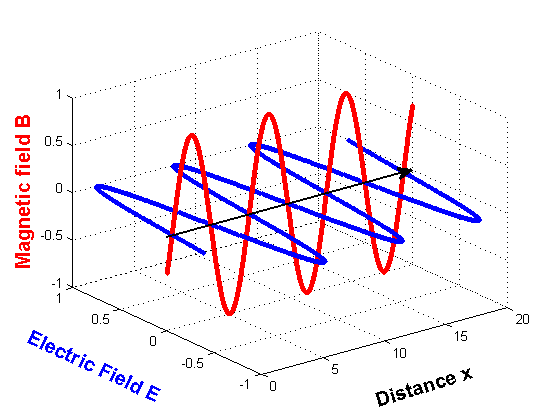 Fundamentals of Propagation
Fundamentals of PropagationWhen a suitable antenna is driven by a radio transmitter it radiates energy into free space in the form of Electromagnetic (EM) Waves. EM waves are produced by a complex mechanism. In close vicinity to the antenna (within 1/2λ to 1λ), the energy field is called induction field. Rapid and progressive transformation takes place in this region going through Rayleigh (reactive) and Fresnel (non-reactive) regions. Finally EM wave is formed which is fully detached from the antenna as it propagates into the Far field region. EM wave carries the entire energy that was passed onto it and travels away into free space at the velocity of light. As it travels, its behavior is governed by the laws of physics and the properties of the medium. The radio propagation medium may not be homogenous and hence the EM wave can get subjected to various physical phenomena like reflection, refraction, absorption, diffraction, etc… Read More.
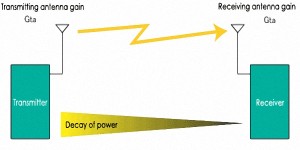 VHF/UHF & Free Space Propagation
VHF/UHF & Free Space PropagationFree Space radio propagation as the term suggests refers to unrestricted propagation through a nearly homogenous medium in the absence of any kind of objects or particle/energy fields that could alter propagation. For practical purpose, radio propagation through inter-planetary space or a terrestrial point-to-point mode when not influenced by presence of earth, buildings, other man-made structures and topological entities like hill, mountains, etc is considered as Free Space propagation. A microwave terrestrial relay link from one tower to another is a classical example. However, in practical scenarios where VHF/UHF links are often influenced by anomalies of weather, causing wave bending due to atmospheric refractive index gradient is also included in this mode… Read More.
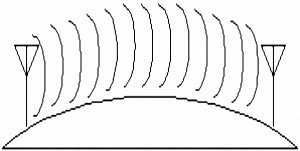 Ground/Surface wave Propagation
Ground/Surface wave PropagationThe term surface Wave is often incorrectly but interchangeably used with Ground Wave. Surface wave is a subset of Ground-wave which also includes Direct waves and Ground reflected waves. Surface wave radio propagation is sensitive to polarization. Practical manifestation of surface waves only occur with vertically polarized signals. Horizontally polarized signals get quickly absorbed by the earth’s soil and hence cannot propagate far enough. Although it is imperative to have vertically polarized TX antenna, ideally both TX and RX antennas should be vertically polarized. This avoids cross-polarization losses. Surface waves only manifest on lower bands like VLF, LF, MF and lower portion of HF. The coverage reduces with frequency whereas better soil conductivity enhances it… Read More.
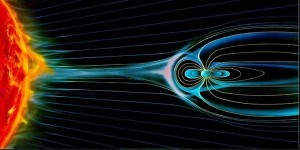 Solar Activity & Ionosphere
Solar Activity & IonosphereShortwave HF radio propagation is almost solely dependent on the presence of Ionosphere. If there was no ionosphere, HF radio would have been limited to short-range surface waves and that too on the lower part of the HF spectrum. Middle and upper HF bands would have been totally dead for terrestrial radio. Unlike VHF/UHF, even the short distance line-of-sight radio propagation would not happen. Due to longer wavelengths on HF, the first Fresnel zone clearance of earth surface would be difficult. Perhaps HF would have served only for low data rate space radio. Fortunately ionosphere exists. It exists only due to a continuous stream of sub-atomic particles and high energy emissions from the sun that travel at high velocity across the solar system. It is called Solar Wind. It interacts with earth’s upper atmosphere to form the ionosphere… Read More.
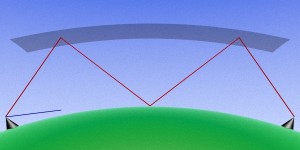 Ionospheric Skywave Propagation
Ionospheric Skywave PropagationThe real utility of HF radio stems from its ability to leverage the properties of Ionosphere to render global communication. Ionosphere is not a homogeneous reflector. It is a huge canopy surrounding the earth starting at 50 Km height and goes up to 600 Km or more. It has multiple graded layers of ionized charge particles which are dynamic and turbulent with time-variant properties. The height and density gradients vary diurnally, seasonally and in accordance with solar activity. Solar activity varies continuously with time and displays a 28 day and a 11 year cycle. The space between earth and ionosphere forms a 3D concentric spherical duct. HF radio waves from the TX antenna bounces back and forth between earth and ionosphere as it hops around the world. This process is complex due to the dynamic nature of ionosphere… Read More.
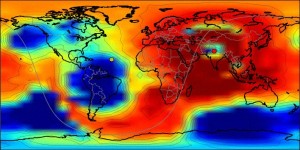 Propagation Forecasting
Propagation ForecastingFollowing and forecasting propagation becomes significant in context of HF radio. At VHF/UHF or higher, the communication link behavior is far easier to compute. At these frequencies, the propagation is stable with very few time or seasonally varying parameters. Such parametric variants have small effect which are factored in by allowing adequate margins. This applies to MF and lower frequencies too. However, HF sky-wave propagation is different. Ionospheric multi-skip propagation circuits are like daisy-chains. Along the path, at each ionospheric contact point, the propagating wave encounters a distinctively different behavior. The ionospheric properties at each of these points constantly alter with earth’s rotation, declination and changing solar activity. Hence, the overall HF circuit performance varies on a minute-to-minute basis… Read More.
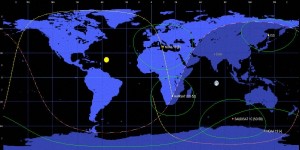 Space Radio Propagation
Space Radio PropagationSpace radio propagation encompasses a vast field including inter-planetary and deep space communications. However, to the amateur radio operator the most significant aspect is satellite communications using artificial satellites and perhaps also the only one earth’s natural satellite, the moon. Since decades ham operators have used dedicated LEO amateur radio satellites to establish contacts over reasonably long distances on VHF/UHF. Amateur space radio opens up new challenges. Apart from a constantly varying Doppler shift, signals encounter diffraction, atmospheric gradients result in bending of propagation paths and also Faraday Rotation that causes polarization shift. EME or moon-bounce adds polarization reversal also. All this is very fascinating… Read More.
List of Articles under this Section
Fundamentals of Radio Propagation An Introductory Primer on Radio Propagation A good understanding of various radio propagation phenomena is vital to leverage propagation conditions to one's advantage in establishing radio communication. Radio wave propagation...VHF/UHF & Free Space propagation VHF/UHF & Free Space Propagation - A primer Radio wave propagation across the entire spectrum including VHF, UHF, and microwave primarily depends on the principles of Free Space propagation. As the radio waves propagate, they are...Atmospheric impact on VHF Radio Propagation Atmospheric influence on VHF Radio Propagation The overall influence and impact of atmospheric conditions on VHF radio propagation are quite significant. In this article whenever I mention VHF, it would usually refer to both VHF...Terrestrial VHF Radio Signal Coverage - LOS Terrestrial VHF Radio Signal Propagation - LOS Though VHF/UHF radio is very popular, why do the terrestrial VHF radio signal coverage losses grow quickly to curtail the useful range to short distances? This is an important question...Terrestrial VHF Radio Signal Coverage - BLOS Terrestrial VHF Radio Signal Propagation - BLOS This is part-2 of the two-part article series on Terrestrial VHF Radio Signal Coverage. This part will focus on Beyond-Line-of-Sight (BLOS) terrestrial VHF radio signal communication,...VHF Propagation Path Profiler - Web App Terrestrial VHF Propagation Path Profiler The VHF Propagation Path Profiler presented here is a comprehensive application that allows us to graphically render and mathematically compute various relevant VHF/UHF propagation metrics...Ground Wave Propagation Is it Ground Wave or surface Wave propagation? Both the terms ground wave propagation, as well as surface wave propagation, are relevant. However, we often tend to use them interchangeably and loosely, which is technically incorrect....HF Surface Wave Propagation (Ground Wave) HF Radio Surface Wave propagation (Ground Wave) Surface Wave propagation and coverage on the HF radio bands is well known to radio amateurs. Especially, on the Lower frequency HF bands called the Top Bands which includes the...Solar Activity and Ionosphere Solar activity and its influence on Ionosphere The most exciting and intriguing aspect of radio propagation is Solar activity leading to the creation of the Ionosphere on earth. The entire universe including our Solar system presents...SSN, SFI, Solar Data for HF Propagation SSN, SFI, Solar Data for HF Radio Propagation Here are some of the important Solar activity parametric data that are responsible for influencing the behavior of the Ionosphere on earth. These, in turn, are instrumental in determining...Ionospheric Skywave Propagation Ionospheric Skywave Propagation - A Curtain Raiser The most important propagation mode for HF radio communication is Ionospheric Skywave propagation. Starting at the bottom of the D-layer and all the way till the top of the F2-layer...Noise in Radio communication Introduction to Radio Communication Noise As important as the desired signal, the aggregate undesired noise in radio communication is a factor that is equally important. The insight into the causes and sources of noise are vital...Radio Propagation Forecasting Radio propagation forecasting and assessment With the advancement in technology over the last few decades, we have made giant strides in Radio Propagation Forecasting and Assessment techniques. The highly volatile and variable nature...Space Radio Propagation An Introduction to Space Radio Propagation The propagation of radio waves for space radio communication primarily takes place by Direct wave (a.k.a. Space wave). The space radio propagation could encompass communication between two...















